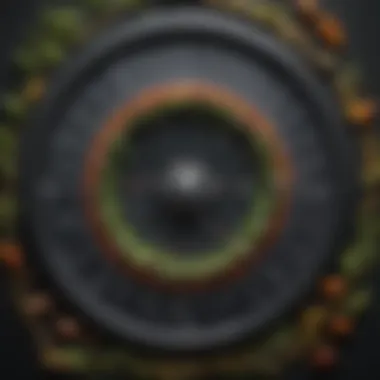SHS Management: Strategies and Solutions for Pest Control


Intro
In the context of pest management, SHS stands for Safe Home Strategies. It represents a holistic approach to maintaining a pest-free environment in homes and professional spaces. This article discusses the various strategies employed in SHS management, focusing specifically on pest control. A comprehensive overview will allow readers, especially homeowners and pest control practitioners, to appreciate the nuances involved in pest identification, prevention, and remediation.
Understanding pests and their behaviors is crucial for effective management. The methods covered herein also underscore the necessity of integrating sustainability and scientific principles into pest control practices. Through this understanding, homeowners can minimize pest interactions and practitioners can adopt best practices that lead to better results.
Pest Identification
Effective pest management starts with accurate pest identification. Recognizing which pests are present in your home enables the right course of action.
Common Household Pests
Some of the most prevalent pests encountered in domestic environments include:
- Ants
- Cockroaches
- Bed bugs
- Termites
- Rodents
Each of these pests poses unique challenges. For instance, termites can cause significant structural damage, while bed bugs can disrupt sleep and lead to psychological stress.
Signs of Infestation
Identifying signs of infestation is crucial. Common indicators may include:
- Unusual droppings
- Visible nests or burrows
- Gnaw marks or damage on structures
- Sudden appearance of pests, especially during seasonal changes
Being alert to these signs can help in initiating timely intervention.
Prevention Methods
Prevention is always better than cure in pest management. There's a myriad of methods applicable for lowering pest risk in households.
Environmental Modifications
Altering the environment can significantly deter pest entry. Here are essential modifications:
- Seal cracks and gaps in walls, windows, and doors.
- Remove standing water to prevent pest breeding.
- Maintain gardens and lawns to reduce habitat.
Home Maintenance Tips
Routine maintenance plays an essential role in pest prevention. Key tips include:
- Regularly clean kitchens and dining areas to eliminate food sources.
- Store food in airtight containers.
- Dispose of garbage properly and frequently.
Implementing these practices can significantly reduce pest attraction and facilitate a healthier living environment.
DIY Pest Control Solutions
For those who prefer hands-on approaches, there are several do-it-yourself methods available.
Natural Remedies
Using natural substances for pest control is an eco-friendly choice. Common natural remedies include:
- Diatomaceous earth (effective against insects)
- Essential oils such as peppermint or tea tree oil for repelling pests
DIY Traps and Barriers
Setting up traps can be an effective means of managing pest populations. Simple traps can include:
- Sticky traps for insects
- Homemade bait traps using sugar or vinegar for ants
Employing these DIY strategies can provide immediate relief and is often inexpensive.
"The best pest control strategy is a combination of education, prevention, and effective techniques tailored to each unique situation."


For more information, you can explore links such as Wikipedia, Britannica, Reddit for community discussions and more tips.
By following these guidelines, homeowners can foster a pest-free environment, while also being mindful of ecological impacts.
Understanding SHS Management
Understanding the intricacies of SHS management is essential in today's world, particularly for homeowners and housewives. This article aims to highlight the key aspects and benefits of effective pest management strategies, which can directly impact one's living environment.
When discussing SHS management, it is crucial to appreciate the diverse methods involved in controlling pests. A comprehensive approach not only safeguards residents' health but also preserves the integrity of the home. Effective pest control can save money in the long run, as it minimizes the potential for damage caused by infestations. Thus, comprehending SHS management allows individuals to take informed actions toward creating a safe and healthy living space.
Definition and Scope
SHS management, or Sustainable Household Solutions management, refers to practices aimed at preventing and controlling pest infestations within homes. This encompasses a range of strategies that prioritize safety, effectiveness, and environmental sustainability.
The scope of SHS management extends beyond mere extermination; it involves understanding pest biology, ecosystem interactions, and employing integrated pest management techniques. Aspects like environmental factors, seasonal changes, and household hygiene are also integral to creating effective pest control plans. The definition of SHS management emphasizes its proactive and educational nature, aiming to empower homeowners through knowledge and resourcefulness.
Historical Context
The historical context of SHS management reveals a fascinating evolution in how societies approach pest control. In ancient times, people relied on basic methods such as natural repellents and physical barriers. As civilizations advanced, so did the techniques. The introduction of chemical pesticides in the 20th century marked a significant turning point in pest management. However, this also led to resistance among some pests and serious environmental concerns.
In recent decades, there has been a shift toward integrated pest management, emphasizing eco-friendly techniques. This evolution reflects an increased awareness of the impacts of chemicals on both human health and the environment. Today, SHS management incorporates sustainable practices that aim to balance human needs with ecological considerations. Understanding this historical context allows individuals to appreciate the ongoing progress in pest management approaches and the importance of adapting to new challenges.
Key Principles of SHS Management
Effective pest management is a critical aspect of maintaining the health and comfort of homes and businesses alike. This section outlines key principles that form the foundation of successful SHS management practices. These principles are not just theoretical concepts; they provide practical guidance applicable to everyday situations involving pest control. Understanding these principles can lead to better informed decisions in pest-related challenges.
Integrated Pest Management
Integrated Pest Management (IPM) is a holistic approach that emphasizes the use of multiple strategies to control pest populations. It combines biological, cultural, physical, and chemical tools in a way that minimizes risks to human health and the environment.
- Importance of IPM:
IPM promotes environmentally sensitive solutions to pest management. By focusing on prevention and monitoring, it allows homeowners to address pest issues before they escalate. This means identifying the root causes and implementing corrective measures that might involve changes to the environment itself. - Techniques in IPM:
- Biological control: This involves using natural predators or parasites to control pest populations. An example is introducing ladybugs to combat aphid infestations.
- Cultural control: Changing farming or gardening practices to reduce pest establishment, reproduction, and survival. This can include crop rotation and selecting pest-resistant plant varieties.
- Mechanical control: Using physical devices such as traps and barriers to prevent pests from accessing particular areas.
- Chemical control: When necessary, the judicious use of pesticides in conjunction with the above methods to achieve effective pest suppression with minimal environmental impact.
"The goal of IPM is not to eradicate all pests but to manage their populations effectively, balancing ecological health with human needs."
It is crucial to regularly assess pest populations and the effectiveness of control measures. This ongoing evaluation helps refine strategies to ensure optimal results while minimizing negative impacts.
Preventive Measures
Preventive measures play a significant role in effective SHS management. These actions can be implemented to deter pests before they invade your space, thereby reducing the likelihood of an infestation.
- Home Inspection: Regular inspections of the home, particularly attics, basements, and other often overlooked areas, help identify signs of pest activity. Look for droppings, nests or any unusual damage that could indicate pests are present.
- Sanitation: Cleanliness is vital in pest control. Keeping food sealed and areas free of crumbs can dramatically reduce attractants for pests. Ensuring that garbage is covered and disposed of regularly also makes a significant difference.
- Sealing Entry Points: Pests often enter through small openings. Inspect windows, doors, and any gaps in walls, and take the time to seal them. Using materials like caulk or weather stripping can keep many pests out.
- Landscaping Practices: Maintaining a well-kept yard can deter pests. Trim overgrown bushes and remove debris. Keep mulch away from the foundation of your house to prevent rodents from nesting.
- Monitoring Moisture Levels: Many pests thrive in moist conditions. Repair leaky pipes and ensure proper drainage to prevent standing water that can attract pests.
Adopting these preventive measures enables householders to create an inhospitable environment for pests, thus significantly decreasing the potential for infestations and the need for long-term pest control solutions.
By prioritizing Integrated Pest Management and preventive measures, homeowners can navigate pest management with greater assurance. This groundwork allows for a more proactive approach, ultimately leading to improved living conditions and a healthier environment.
Challenges in SHS Management
Effective SHS management involves navigating various challenges that can hinder successful pest control initiatives. Understanding these challenges is critical as it allows homeowners and pest management professionals to develop informed strategies that can mitigate risks and improve outcomes. This section dissects three primary challenges in SHS management: identification of pests, resistance development, and environmental concerns. By addressing these elements, the article aims to equip readers with insights necessary for comprehensive pest management.
Identification of Pests
Identifying pests correctly is foundational to effective pest management. Different pests require different control strategies. Misidentification can lead to incorrect treatment, ineffective solutions, and unnecessary use of chemicals. For instance, distinguishing between a bedbug and a carpet beetle can change the course of action significantly. Homeowners or professionals using visual inspection might overlook subtle differences that indicate specific infestations.
Being aware of the signs of an infestation is beneficial. This includes unusual markings, droppings, or physical sightings. Moreover, technological advancements facilitate this process. Smartphone applications and identification guides can assist in identifying pests accurately. Another effective approach involves consulting with professional pest control services for expert opinions.
Resistance Development
Resistance development amongst pests is a significant concern in SHS management. Over time, pests can become immune to certain pesticides, leading to ineffective treatments and ongoing infestations. This phenomenon is often the result of excessive or improper use of chemicals. For instance, the ongoing use of pyrethroids may encourage mosquito populations to adapt, rendering these products useless.
To combat resistance, an integrated pest management approach is crucial. This method combines monitoring, resistance prevention, and the use of alternative control strategies. Homeowners can also take proactive steps. Rotating pesticides and varying application methods can break the cycle of resistance. It is crucial to emphasize that sustainable practices not only protect against resistance but also contribute to overall environmental health.


Environmental Concerns
The growing emphasis on environmental concerns in SHS management cannot be understated. The impact of pesticides on surrounding ecosystems often raises questions about biodiversity and health. Chemicals can affect non-target species, leading to ecological imbalances and harming beneficial insects. Thus, awareness and responsibility are necessary when selecting pest management techniques.
Bio-based pest control solutions are gaining traction as eco-friendly alternatives. Organic substances derived from plants and animals are often less harmful to the environment and human health. Education regarding the impacts of various products educates clients and can steer them to choose responsible pest control options.
"A responsible approach to pest management can mitigate the potential negative impact on the environment while effectively addressing pest concerns."
Effective SHS management is paramount for all homeowners. Recognizing challenges like effective identification of pests, resistance development, and environmental concerns ensures that strategies are crafted with an understanding of both immediate needs and long-term sustainability.
Effective Strategies for SHS Management
The topic of effective strategies for SHS management is crucial to ensuring successful pest management in every setting. Employing a well-rounded approach can lead to sustainable solutions that benefit both homeowners and pest control practitioners. The strategies outlined below not only help in controlling pests effectively but also promote a healthier environment while balancing the needs of society and natural ecosystems.
Cultural Practices
Cultural practices form a foundational aspect of pest management strategies. This involves modifying the environment to make it less conducive to pest infestations. For instance, proper sanitation can significantly reduce pest populations. Maintaining cleanliness around homes, including regularly disposing of waste and keeping food sealed, enhances the efficacy of pest control.
Additionally, proper landscaping can deter pests. Selecting plants that are resistant to pests can minimize infestations. For example, using marigolds or lavender can naturally repel certain insects.
In gardens, crop rotation is a valuable cultural practice. By changing the types of plants grown in a particular area, pests that thrive on certain plants can be disrupted, reducing their population over time. Further, community involvement in cultural practices can lead to collective efforts, thus amplifying effectiveness.
Mechanical Control Methods
Mechanical control methods are practical options that involve the physical removal of pests. These tactics include traps and barriers that can effectively prevent pests from accessing your home or garden.
Traps can be especially useful for rodents and insects. For example, sticky traps capture insects when they come into contact, providing a straightforward solution for small infestations. Other devices, such as ultrasonic pest repellents, offer a non-invasive way to deter disturbances in your living space.
Physical barriers, including screens and mesh netting, can block pests from entering indoor spaces. By regularly inspecting and repairing any gaps or cracks in structures, homeowners can reduce access points. This additional layer of diligence can lead to long-term pest management success.
Chemical Control Solutions
Chemical control solutions should be considered as a last resort in pest management. However, when necessary, it is imperative to choose the right products and apply them safely and responsibly. There are various chemical solutions available, from insecticides to herbicides, each designed to address specific types of pests.
Before opting for chemical treatments, it is important to conduct thorough research. Understanding the active ingredients in products can guide the selection of a safer option that minimizes risks to humans, pets, and the environment.
Careful application is essential. Homeowners should follow label instructions meticulously and consider applying treatments during times when human activity is low, reducing exposure risks. Combining chemical solutions with other strategies, such as mechanical and cultural practices, often leads to better overall results.
The Role of Technology in SHS Management
Technology plays a crucial role in the effective management of pest control strategies. It allows homeowners and practitioners to access advanced tools that improve accuracy and efficiency in pest identification and management. As our understanding of pests evolves, so too does the technology designed to combat them. From software applications that track pest populations to innovative devices that disrupt pest life cycles, technology offers insights and solutions previously unattainable.
The benefits of integrating technology into SHS management extend beyond merely addressing pest issues. They include enhanced data collection, better decision-making capabilities, and cost reductions in pest control practices. Now let’s examine two significant technological advancements shaping the landscape of SHS management.
Data Analytics and Pest Tracking
Data analytics equips pest managers with the ability to collect and interpret vast amounts of information about pest behaviors and environmental conditions. By analyzing historical data alongside real-time information, practitioners can identify patterns that indicate pest infestations. For instance, specific weather conditions might correlate with increased pest activity, enabling timely interventions.
Pest tracking technologies, such as sensors and IoT devices, further refine this process. They enable constant monitoring of pest populations and their movements. This timely awareness allows for prompt action, which is essential in preventing significant infestations.
Additionally, the integration of data visualization tools helps present complex data in a more digestible format. This clarity assists homeowners in understanding pest trends, crucially arming them with the knowledge needed to implement preventive measures effectively.
"The integration of data analytics and technology in pest management allows for more informed decisions, reducing the risk of infestations while maintaining eco-friendly practices."
Innovative Pest Control Products
Innovative products are reshaping the pest control sector, offering more effective and safer solutions. Products such as pheromone traps and bio-based insecticides serve as alternatives to traditional chemical treatments. These innovations not only minimize potential harm to humans and pets but also address growing concerns about environmental sustainability.
Furthermore, smart pest control solutions such as automated traps and targeted application systems demonstrate how automation is improving pest management. These products can be programmed to respond to specific triggers, optimizing their efficacy and reducing waste. By employing such technologies, homeowners can manage pest issues with minimal effort, ensuring their environments remain pest-free.
In summary, technology serves as a vital ally in the battle against pests. Through data analytics and innovative products, effective strategies emerge that empower homeowners and pest control professionals alike with the tools necessary for successful management.
Education and Training in SHS Management


Education and training in SHS management play a critical role in equipping both homeowners and pest control practitioners with the knowledge and skills necessary to tackle pest-related issues effectively. This section explores the specific elements of education and training that are pivotal in fostering a competent approach to pest management, highlighting the benefits and considerations that arise within this domain.
Professional Certifications
Professional certifications are vital in SHS management, providing validation of expertise in pest control practices. They not only enhance an individual’s credibility but also ensure that they are aware of the latest techniques and regulations in pest management. Certifications such as those offered by the National Pest Management Association (NPMA) or the Pest Control Operators of California are highly regarded in the field.
A well-structured certification program can include:
- Theoretical knowledge: Understanding the biology of pests, their behaviors, and effective control methodologies.
- Practical training: Hands-on experience in safe pesticide application techniques and integrated pest management (IPM) strategies.
- Continuing education: Keeping up with advancements in pest control technologies and changing regulations.
Certifications help to instill confidence in consumers looking for pest management solutions, ensuring that they select certified professionals who adhere to best practices.
Public Awareness Campaigns
Public awareness campaigns are another essential aspect of education and training in SHS management. These campaigns aim to inform the community about pest identification, preventive measures, and responsible pesticide use. By raising public awareness, these initiatives can lead to proactive attitudes towards pest control, reducing infestations and encouraging sustainable practices.
Key elements of effective public awareness campaigns include:
- Information dissemination: Utilizing various channels, such as social media, local workshops, and community events to educate the public.
- Collaborations: Partnering with local government agencies, schools, and print media to broaden the reach and impact of campaigns.
- Feedback mechanisms: Encouraging community input to tailor education efforts effectively.
"Raising public awareness about pest management practices is crucial for fostering a community that understands both the risks and solutions to pest issues."
Investing in education and training, through certifications and public campaigns, provides the foundational knowledge necessary for effective SHS management. Homeowners who are empowered with knowledge can make informed decisions about pest control, leading to healthier living environments.
Future Trends in SHS Management
Identifying future trends in SHS management is crucial to adapting pest control strategies as environmental concerns and technology evolve. Homeowners and pest control professionals must remain informed to ensure effective methods are utilized while minimizing ecological impact. As society becomes increasingly aware of sustainability, it shapes the discourse around pest management.
Sustainable Practices
Sustainable practices in SHS management emphasize ecological balance. These practices aim to minimize chemical usage, promote biodiversity, and utilize organic methods. Homeowners can adopt a variety of sustainable measures. Utilizing native plants in landscaping can reduce the need for chemical interventions. Companion planting, which involves growing certain plants together for mutual benefit, is another effective strategy. This practice can deter pests naturally, lowering reliance on synthetic pesticides.
Here are some sustainable practices to consider:
- Biological Control: Introducing natural predators, such as ladybugs for aphids, to control pest populations.
- Organic Pesticides: Using substances like neem oil or diatomaceous earth, which are less harmful to the environment.
- Regular Maintenance: Keeping gutters clean and inspecting for leaks to reduce pest attractants.
These practices not only enhance the resilience of the local ecosystem but also create a safer living space for families. Educating homeowners about these methods can promote a collaborative effort towards a more sustainable future.
Research and Development
Research and development play an integral role in advancing SHS management techniques. Innovations in pest control research can lead to the discovery of more effective and environmentally friendly methods. Institutions and companies focus on developing pest-resistant crops through genetic modification, which can significantly reduce the need for chemical treatments in gardening and agriculture.
In addition to genetic advancements, research in chemical alternatives is thriving. For example, scientists are exploring plant-based solutions, which can effectively deter insects without the side effects associated with traditional pesticides. This focus on R&D can result in:
- Improved Pest Monitoring Tools: Development of smart traps that use sensors and apps for real-time pest tracking.
- Eco-Friendly Pest Solutions: New formulations that are potent yet biodegradable, ensuring less environmental harm.
- Education Initiatives: Ongoing research feedback informs public awareness programs, empowering individuals with knowledge about pest management.
"Investing in research is key to unlocking sustainable solutions for SHS management, allowing for innovations that cater to both efficacy and ethics."
Future-oriented strategies in SHS management hinge on three pillars: sustainability, active engagement in research, and adaptation to emerging technologies. These trends not only aim to improve pest control but also enhance overall environmental health, providing long-term benefits for homeowners and communities.
The End
In summary, the conclusion of this article plays a crucial role in reinforcing the concepts and practices discussed throughout. It provides readers with a cohesive understanding of the multifaceted nature of SHS management. By articulating the importance of strategies, challenges, and sustainable practices, it gives a final synthesis for all the previously covered elements. Readers can appreciate the depth of the subject matter and understand its significance in both domestic and professional contexts.
Summary of Key Points
The article outlined several essential aspects of SHS management, notably the following:
- Influence of Historical Context: Recognizing the evolution of pest control practices aids in comprehension of current methodologies.
- Key Principles: Effective pest control relies on integrated pest management and preventive measures that consider environmental impacts.
- Challenges: Identification and resistance are prominent concerns impacting pest management.
- Effective Strategies: Emphasis on cultural practices and innovative control methods, including mechanical and chemical approaches, is necessary for homeowners.
- Technological Advancements: The role of technology and data analytics transforms pest management, providing new insights.
- Education and Training: Professional certifications and public awareness campaigns enhance knowledge among practitioners and homeowners.
- Future Trends: Sustainable practices and ongoing research are vital to adapt to changing environments and regulations.
This concise summary can assist housewives and home owners in engaging with the concepts presented, empowering them to make informed decisions about pest management in their own spaces.
The Importance of Ongoing Research
Research in SHS management continually shapes the landscape of pest control. It fosters advancements that can lead to more effective, environmentally friendly, and sustainable practices. Ongoing studies help in:
- Developing new methods to combat pest resistance and address emerging threats.
- Enhancing public health safety through improved pest management practices that minimize harmful exposures.
- Informing regulatory frameworks that ensure pest control measures are safe and effective.
- Encouraging collaboration between researchers, industry professionals, and the public, which is essential for sharing knowledge and best practices.
By prioritizing research, stakeholders can continuously adapt to the dynamic nature of pest management, addressing new challenges as they arise. This focus will not only benefit current practices but also lay the groundwork for the future of SHS management.















